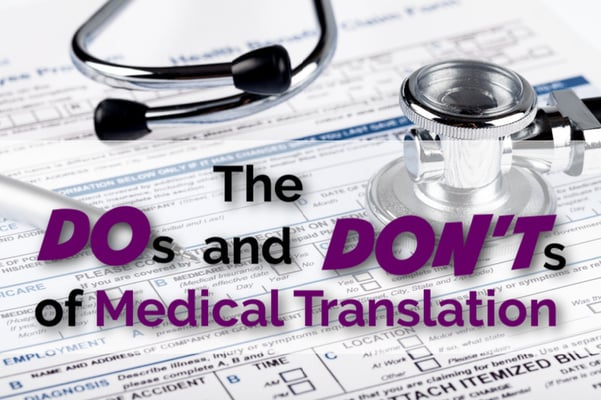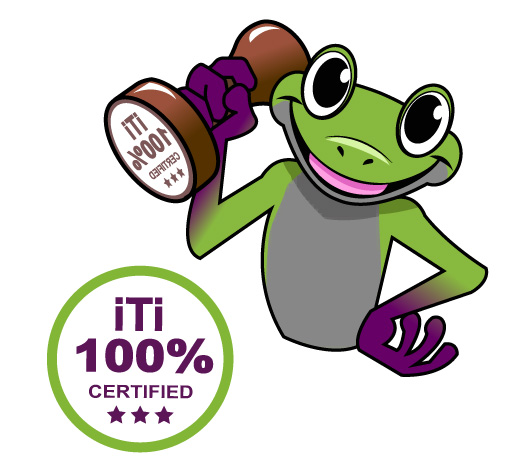
Interpreting – the spoken word. Translation – the written word.
As a healthcare provider, you already know that communication is the key to excellence in the patient experience. For your non-English-speaking patients and their families, medical scenarios can be confusing and even frustrating. You’re taking steps to make sure that medical interpreting services are available to those who need them. Are you making the same effort when it comes to translation of your written communications?
Here are some dos and don’ts to consider when seeking medical translation services.
But wait! Before we dive into the dos and don’ts, let’s take a moment to define what we mean by “written communications.”
Don’t forget translation to English! If your patient was previously treated in a different country, it is likely their records are in another language. Accurate medical record translation will give you the information you need to provide the best possible care.
In healthcare, your bilingual employees can be enormously helpful. They can also become huge liabilities when not professionally trained (see our blog post on the topic here). No matter their level of medical expertise, they are not professional translators. Much like interpreting, translation is a special skill and requires very specific training.
At iTi, we adhere to the highest standards for our professional translators. We’re proud of our rigorous qualification, testing and hiring process, as well as our established quality monitoring procedures. Our clients agree, and awarded our Translation Department an NPS[1] score of 89 for 2022! (For context: Starbucks, a consistent high scorer, earned 77 in 2022.)
 Unless you have a dedicated team of trained medical translators on staff, you will need to use a medical translation company to handle this important task. Be sure the company has a history of working with healthcare clients.
Unless you have a dedicated team of trained medical translators on staff, you will need to use a medical translation company to handle this important task. Be sure the company has a history of working with healthcare clients.
Interpreters and Translators, Inc. has been in business for more than 36 years. We work with large health and hospital systems, multi-practice offices, and specialty wellness groups throughout the country. Our medical translators are trained in and keep up-to-date with the ever-evolving language of the medical world.
Also, before you choose a medical translation provider, ask whether they offer certified document translation. At iTi, if the accuracy of one of our certified translations ever needs to be established in a legal proceeding, the company will attest to it, even to the point of testifying in court if necessary.
The use of artificial intelligence (AI) has gotten a lot of press recently, and machine translation has certainly come a long way over the last few years. But it is absolutely the wrong choice for medical translation.
In a study by the British Medical Journal, a tech-savvy clinician and consultant team chose ten phrases often used by doctors in a clinical setting and translated them into 26 languages with Google Translate. For the sake of detail, they covered languages of a wide variety of linguistic families, including 8 Western European, 5 Eastern European, 11 Asian and 2 African.
According to the study, “the algorithm did not perform well, with Western European languages approaching 74% correct rates, Eastern European languages following with 62% correct rates, Asian at 46%, and African languages finishing last at 45%. Overall the correct language percentage for all languages was 57.7%.”
Don’t assume that, because you contracted a translation company, AI is not being used for your translations! Some language companies use AI as part or even all of their process. At iTi, we only use human translators who are native speakers of the target language. Period.
You know we had to say it! You have questions, we have answers. Click the link below to get in touch with one of our healthcare language solutions specialists.
| ↑1 | Net Promoter Score is a marketing research metric for client experience, based on the likelihood they would recommend a company, product or service to a friend or colleague. |
|---|
The original version of this page was published at: https://blog.ititranslates.com/2023/02/14/dos-and-donts-of-medical-translation/
Our healthcare language services ensure compliance by the Joint Commission and improved patient satisfaction. iTi's suite of health language services enables seamless contact between patients and m... Read more
Coca-Cola, McDonalds, Nike, KFC, Marlboro…it probably doesn’t surprise you that people all around the world recognize these brand names just as easily as you do. They’re ...read more
What is Localization in Translation?Localization is the process of adapting text, images, videos, marketing campaigns and more, to fit the linguistic, cultural and societal norms of ...read more
International Domains & Website LocalizationA website localization project is a complex procedure with many moving parts and considerations to manage that can vary widely ...read more
Virtual calls are not only commonplace these days, but most of us have become pros at them. Did you know you can include an interpreter on these calls to help your Limited English ...read more